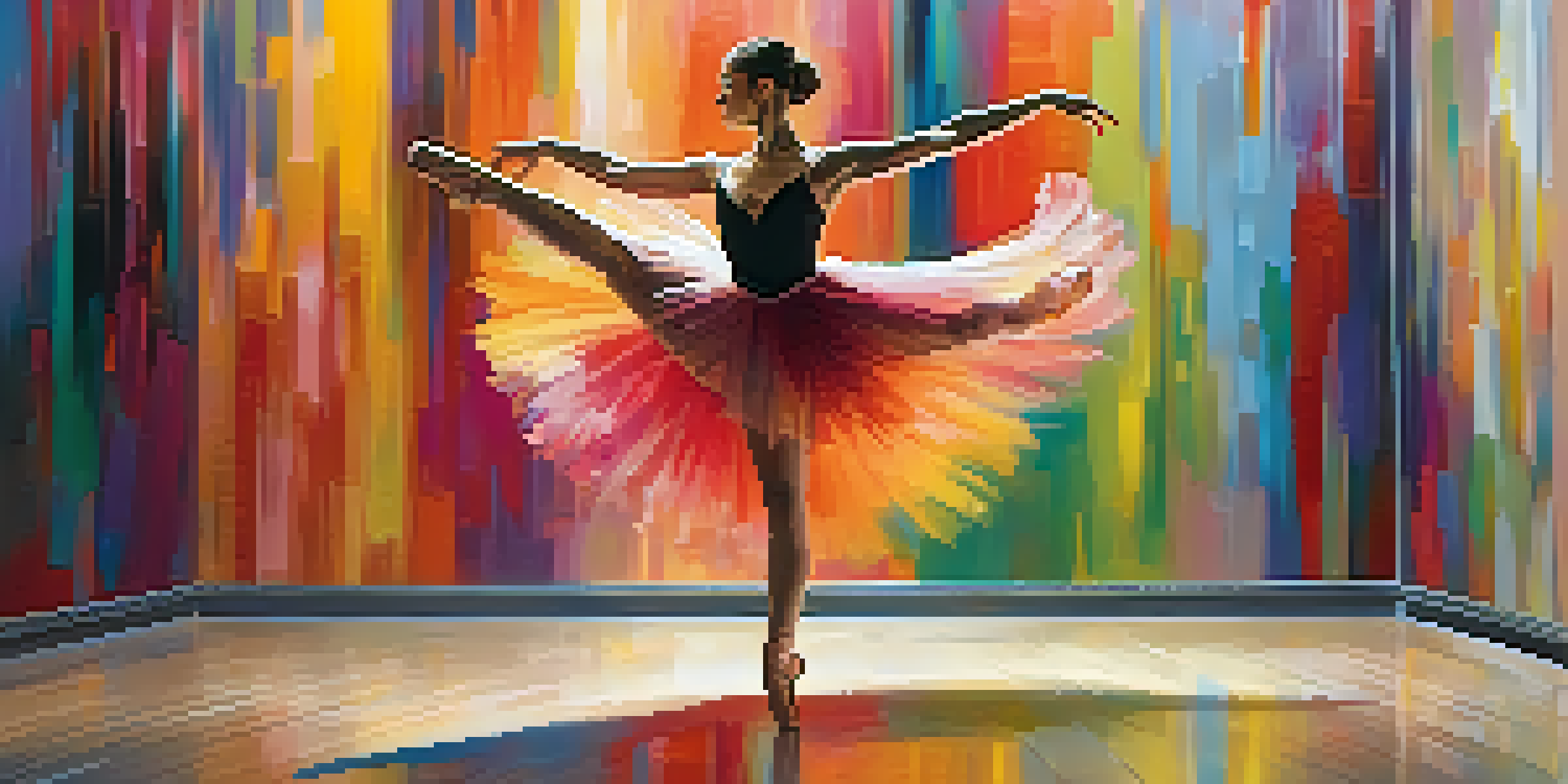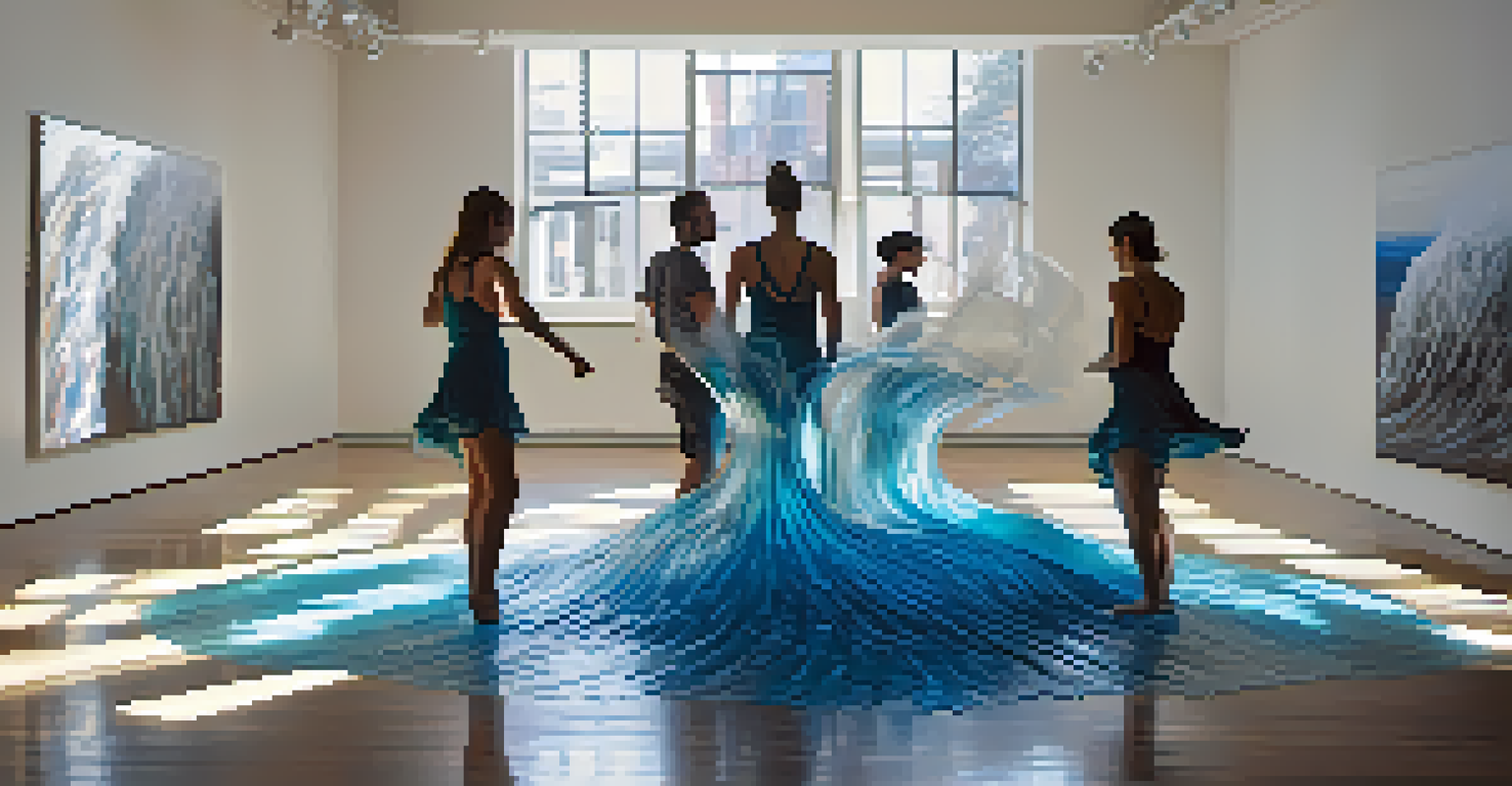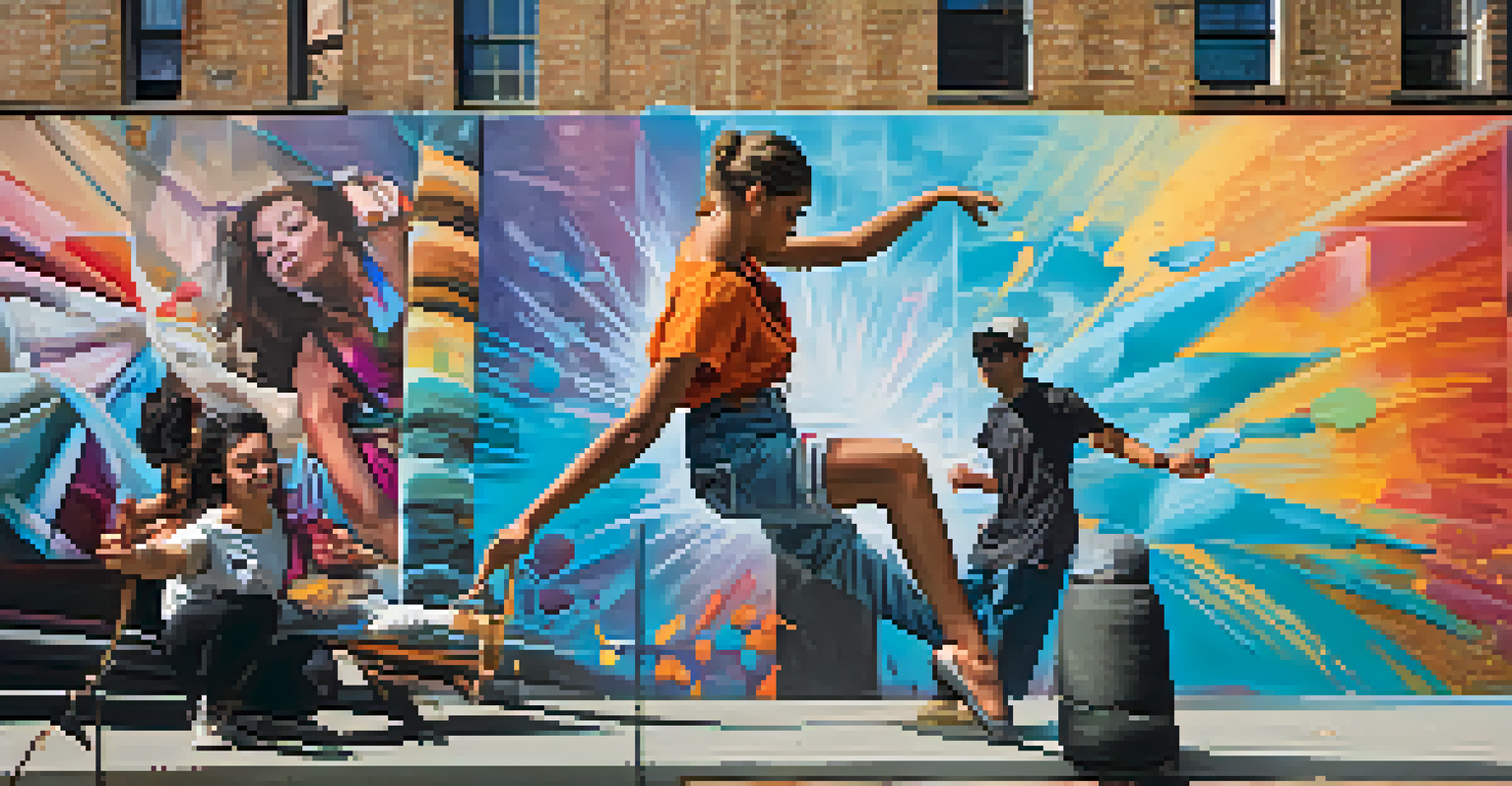The Intersection of Dance and Visual Arts: A Harmonious Blend

Understanding the Connection Between Dance and Visual Arts
Dance and visual arts may seem like distinct forms of expression, but they share a rich history of collaboration. Both disciplines rely on movement and emotion to convey stories and feelings, making them natural partners in artistic exploration. Just as a painter uses brushstrokes to create a scene, a dancer uses body movement to express similar themes.
Dance is the hidden language of the soul.
Consider how a dancer interprets a painting; their movements can mirror the colors and shapes found on canvas. This kinesthetic response transforms static art into a dynamic experience, inviting the audience to engage on a deeper level. The connection between these two art forms enhances the narrative, allowing for a more profound understanding of the artwork.
Moreover, this intersection cultivates a dialogue between the two mediums, where choreographers and visual artists can collaborate to create interdisciplinary works. The blending of dance and visual arts not only enriches each form but also encourages artists to push boundaries and explore new creative avenues.
The Role of Movement in Enhancing Visual Art
Movement plays a vital role in how we perceive visual art, adding an element of life and dynamism. For example, when a dancer performs in front of a painting, the artwork can take on new meanings, as the dancer’s body interacts with the visual elements. This interaction can create a mesmerizing experience, transforming a static image into a living narrative.

Additionally, artists often draw inspiration from dance itself, incorporating fluidity and rhythm into their visual pieces. Think of how sculptures can reflect the grace of a dancer’s pose, capturing a moment of motion in a still form. This interplay invites viewers to experience art in ways that evoke both visual and emotional responses.
Dance and Visual Arts Unite
The rich collaboration between dance and visual arts enhances storytelling and emotional engagement through movement.
Such movement can also be seen in contemporary installations, where choreographed performances enhance the viewer's experience. By inviting audiences to participate, these works challenge the traditional ways we engage with art, creating immersive environments that celebrate both movement and sight.
Historical Perspectives: Dance and Visual Arts Through Time
Historically, the relationship between dance and visual arts dates back centuries, with various cultures incorporating both into their traditions. Ancient civilizations often depicted dancers in murals and sculptures, showcasing the importance of movement in their artistic expressions. These early representations highlight how intertwined dance and visual arts have always been.
Art is the most beautiful of all lies.
During the Renaissance, artists like Leonardo da Vinci explored the anatomy of movement, which influenced both painting and dance. His studies on human figures helped dancers understand their bodies better, improving their technique and performance. This era marked a significant shift where visual arts began to capture the essence of dance more intricately.
In modern times, this connection continues to evolve, with artists and choreographers drawing upon historical influences to inform their contemporary work. Festivals and exhibitions often feature collaborative projects that celebrate this rich history, showcasing how far the intersection of dance and visual arts has come and where it may lead.
Interdisciplinary Collaborations: A New Wave of Creativity
Today, we see a growing trend of interdisciplinary collaborations between dancers and visual artists, creating innovative works that challenge traditional boundaries. These partnerships allow for a fusion of ideas, where each medium informs and enhances the other. A prime example is multimedia performances that integrate video projections, painting, and live dance, creating a captivating sensory experience.
Such collaborations not only broaden the scope of artistic expression but also reach wider audiences. By blending different art forms, artists can draw in people who may have a preference for one medium over another, fostering a greater appreciation for both. This cross-pollination of ideas encourages creativity that transcends conventional labels.
Interdisciplinary Innovations
Collaborations between dancers and visual artists are creating innovative works that challenge traditional boundaries and broaden artistic expression.
Moreover, these partnerships often lead to unique storytelling methods, as the narrative can shift depending on how the visual elements and dance are combined. This dynamic relationship invites audiences to interpret the work in diverse ways, making the experience personal and engaging.
Case Studies: Successful Integrations of Dance and Visual Arts
Several artists and companies have successfully integrated dance and visual arts, serving as inspiring case studies for future collaborations. One notable example is the work of choreographer Merce Cunningham, who partnered with visual artist Robert Rauschenberg to create groundbreaking performances that merged movement and visual aesthetics. Their innovative approach challenged audiences to reconsider the boundaries of both art forms.
Another fascinating case is the collaboration between contemporary dance companies and visual installations, such as those seen at the Venice Biennale. These performances transform the space, utilizing the environment as an integral part of the artwork, allowing the audience to experience dance in a new context. The result is a powerful blend that captivates and engages viewers.
These examples illustrate the vast potential for creativity when dance and visual arts come together. By examining successful integrations, emerging artists can draw inspiration and explore their own unique approaches to this harmonious blend.
The Impact of Technology on Dance and Visual Arts
In the digital age, technology plays a crucial role in transforming the intersection of dance and visual arts. From virtual reality experiences to digital projections, artists can now explore new dimensions of creativity that were previously unimaginable. This technological evolution allows for more immersive experiences that captivate audiences and enhance storytelling.
For instance, choreographers can use motion capture technology to create stunning visuals that accompany their performances. This fusion of dance and technology not only elevates the artistic experience but also opens the door for innovative collaborations across various platforms, including film and interactive installations. Artists can now reach audiences in ways that were once limited to traditional performances.
Technology Transforms Art
Advancements in technology are enabling more immersive experiences in dance and visual arts, fostering greater audience engagement and creativity.
Moreover, social media has allowed for greater visibility of these collaborations, enabling artists to share their work with a global audience. This interconnectedness fosters a vibrant community that celebrates the fusion of dance and visual arts, encouraging ongoing dialogue and collaboration across the world.
The Future of Dance and Visual Arts: Trends and Predictions
Looking ahead, the future of dance and visual arts is ripe with possibilities as artists continue to explore new dimensions of collaboration. Emerging trends suggest a greater emphasis on sustainability and eco-conscious practices, as artists seek to merge their work with themes of environmental awareness. This shift could lead to transformative projects that inspire change through the lens of both dance and visual arts.
Additionally, as technology advances, we can expect to see more interactive and participatory experiences that engage audiences in unprecedented ways. Immersive performances that invite audience involvement will likely become more common, allowing individuals to co-create within the artistic space. This evolution will further blur the lines between artist and audience.

Ultimately, the intersection of dance and visual arts will continue to flourish as artists push boundaries and redefine what it means to create together. By embracing collaboration, innovation, and inclusivity, the future of these two art forms promises to be vibrant, dynamic, and full of potential.